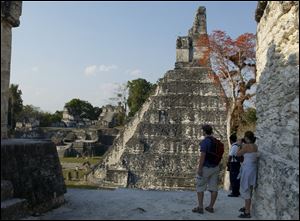
Mayan culture continues to amaze
2/26/2018
Temples and palaces in Tikal, one of the best known Maya sites in northern Guatemala, March 24, 2005. Not far from the sites tourists already know, laser technology has uncovered about 60,000 homes, palaces, tombs and even highways in the humid lowlands in 2018.
The ancient civilization of Maya still fascinates us, more than 500 years after Europeans discovered Central America and began conquering or absorbing the indigenous cultures.
Click here to view more Blade editorials | Check out the Behind The Editorial series
Six years ago, some feared that the world was coming to an end, as foretold by the Mayan calendar. It turned out that the Mayans were very advanced, but not advanced enough to accurately predict the end of the world.
Their own world, however, did come to an end. The Spanish conquest finished off the Mayan empire, but it was an empire already in decline for hundreds of years.
The latest news about the Maya is that new laser technology was utilized to detect tens of thousands of structures, roads, canals, and farm fields hidden in the jungle overgrowth of Guatemala. Researchers are now speculating that the population supported by Mayan agriculture was around 10 million.
This discovery buttresses the growing beliefs of historians, anthropologists, and archaeologists that the human population on this continent was much larger, more organized, and more civilized before the arrival of Europeans than was previously believed.
Follow @BladeOpinion on Twitter.